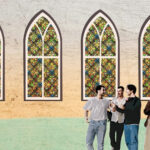Our journey through The Moral Vision of the New Testament continues as Richard Hays devotes a series of chapters to the New Testament’s witness regarding specific, controversial issues. (If you’ve gotten behind in the reading or you’re just joining us, see the reading schedule here.)
Two weeks ago, we looked at the question of Christians using violence in the defense of justice. Last week, we looked Hays’ treatment of divorce and remarriage. Today, we tackle the controversial issue of homosexuality by asking Hays’ question: How is Scripture rightly to be employed in our deliberations about this matter?
Key Texts
Hays admits that the Bible rarely discusses homosexual behavior, but in both Old and New Testaments, the texts are “unambiguously and unremittingly negative in their judgment.”
- Gen. 19:1-29: Hays believes the story of Sodom and Gomorroah is irrelevant to the topic because its focus is gang rape and other passages focus on the city’s pride and excess (Ezekiel 16:49).
- Leviticus 18:22, 20:13: The holiness code explicitly prohibits male homosexual intercourse.
- 1 Cor. 6:9-11, 1 Tim 1:10, Acts 15:28-29: The early church adopted the Old Testament’s teaching on sexual morality, including the prohibition of homosexuality.
- Romans 1:18-32: Hays believes this to be the most crucial text for Christian ethics concerning homosexuality because it condemns homosexual behavior from a theological framework. In this context, it is an example of idolatry, an expression of humanity’s rejection of God’s design, and the consequence of God’s wrath.
Synthesis: Homosexuality in Canonical Context
Hays does not see diversity in the New Testament corpus, since the witness against homosexual practice is univocal. But how do we understand this prohibition within the larger canonical framework?
- First, we note that God’s creative intention for human sexuality is the backdrop for New Testament teaching.
- Secondly, the Bible describes our fallen human condition as being in “a state of self-affirming confusion” as a result of our bondage to sin.
- Third, the Bible undercuts our cultural obsession with sexual fulfillment by “demythologizing sex.” Sexuality is never the basis for defining identity.
Next, Hays looks at the question through the three focal lenses:
Community: Sex is not a purely private affair, but something that concerns the church. To engage in sexual immorality defiles the body of Christ.
Cross: The cross models the way the church should respond to persons of homosexual inclination: not in condemnation but sacrificial service. The power of the cross means “no one in Christ is locked into the past or into a psychological or biological determinism.”
New Creation: Christians struggle to live faithfully in the present time. The transforming power of the Spirit is already present, and yet we live with the reality of temptation.
Hermeneutics: Responding to the New Testament’s Witness Against Homosexuality
Where do we go from here? How do we apply the New Testament texts to the issues of today, “as the church faces new and forceful demands for the acceptance and ordination of homosexuals?” Hays starts by showing how the New Testament speaks to the issue:
- Rule: The New Testament affirms the witness of the Old, but does not clearly articulate a rule against homosexual practice.
- Principle: The prohibition is part of what it means to honor God’s creative design and glorify Him with our bodies.
- Paradigm: In the paradigmatic mode, the New Testament is emphatically and entirely negative.
- Symbolic world: Homosexual activities are “explicitly and without qualification” identified as symptomatic of humanity’s rebellion against God.
- Other Authorities: Tradition of the church has considered homosexuality as contrary to God’s will. Reason makes the case for sexual orientation that is unchangeable, but research is disputed, and even if a genetic link for same-sex preference were proven, it would not make homosexual behavior morally appropriate. Experience of homosexuality today may be different than in biblical times, but the Bible’s witness is clear.
Hays concludes:
“Marriage between man and woman is the normative form for human sexual fulfillment, and homosexuality is one among many tragic signs that we are a broken people, alienated from God’s loving purpose.”
Living the Text: The Church As Community Suffering with the Creation
- Should the church support civil rights for homosexuals? Hays says yes.
- Can homosexuals be members of the Christian church? Yes, they already are, but like all believers, they must reshape their identity in conformity with the gospel.
- “Is it Christianly appropriate for Christians who experience themselves as having a homosexual orientation to continue to participate in same-sex erotic activity?” No. Unless they enter a heterosexual marriage, they should seek disciplined sexual abstinence. “Sexual gratification is not a sacred right, and celibacy is not a fate worse than death.”
- Should the church sanction and bless homosexual unions? No.
- Is the imposition of celibacy on homosexually oriented persons different? No. Heterosexually oriented persons are also called to abstinence apart from marriage.
- Should homosexuals expect to change their orientation? Hays gives an eschatological response of “already / not yet.” Unless we live with the hope of the Spirit’s transforming power “already” available, we are hoping for too little from God. Meanwhile, the “not yet looms” large and many may not experience freedom from this struggle in this life.
- Should persons of homosexual orientation be ordained? Yes, if seeking to live a life of disciplined absence.
Some Personal Considerations: The opening of this chapter differs from the other in that Hays tells the story of his friend, Gary, a gay man who wrestled with the biblical teaching on sexuality and eventually came to the conclusion that he must renounce homosexual activity as part of his pursuit of Christ. Hays was wise to begin this chapter with a personal story. Too often, the perception of the church is that Christians are more concerned about having the right position on homosexuality than loving and serving our gay and lesbian friends and neighbors. By beginning and ending this chapter with reference to Gary, Hays reminds us that the discussion concerns people made in God’s image, people we are called to love and serve.
Hays’ chapter on homosexuality, recommended by N. T. Wright as the best brief treatment of the issue, puts forth a consistent ethic of sexuality that is based in God’s design, Scriptural support, and the tradition of the church. I have quibbles here and there: his brushing aside the sexual element of Sodom’s sin (referenced in Jude 7), and his blanket endorsement of “civil rights” without qualification. (Does supporting protections for gays and lesbians against unjust discrimination mean he would support the civil redefinition of marriage?)
Hays’ words of counsel for the church are based in love and Christ’s call to holiness, but it is hard to imagine how his vision would play out in real life unless one is part of a community that practices meaningful church discipline. Implementing his suggestions seems almost impossible apart from a biblically functioning church.
What do you think of Hays’ summary of New Testament teaching on this controversial issue?

















